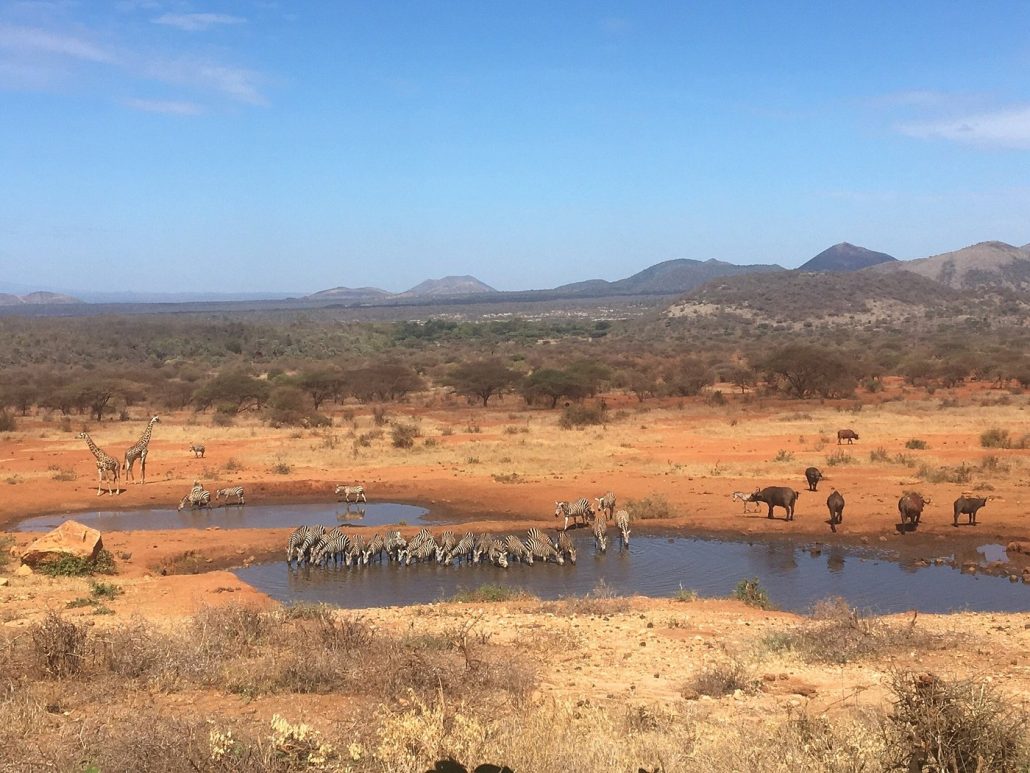Tsavo West National Park
Tsavo West National Park, established in 1948, is part of the larger Tsavo National Park ecosystem in Kenya and covers an area of approximately 9,065 square kilometers (3,500 square miles). Located in the southwestern part of the Tsavo ecosystem, the park is renowned for its stunning landscapes, diverse wildlife, and unique geological features. Tsavo West is characterized by a mixture of savanna grasslands, volcanic hills, and dense woodlands, all interspersed with rivers and swamps. The park is named after the Tsavo River, which runs through the area, providing essential water sources for the wildlife.

One of the park’s most famous features is the Mzima Springs, a series of natural springs that produce crystal-clear water, attracting a variety of wildlife and supporting a unique ecosystem. The park is also known for its stunning vistas, such as the Sheldrick Falls and the Chyulu Hills, which provide breathtaking views of the surrounding landscapes. Tsavo West is home to the Big Five (lion, leopard, buffalo, elephant, and rhinoceros) and offers a tranquil alternative to some of the more crowded parks in Kenya.
Wildlife & Scenery
Tsavo West National Park is a wildlife haven, with a diverse array of animal species that roam its varied landscapes. The park is particularly famous for its large populations of elephants, which can often be seen dusting themselves with the park’s distinctive red soil. Tsavo West has a healthy population of both the African black rhinoceros and the white rhinoceros, making it one of the best places in Kenya to see these endangered species in their natural habitat.
In addition to elephants and rhinos, visitors can expect to see buffalo, giraffes, zebras, and various species of antelope, such as Grant’s gazelle and eland. The park is also home to predators, including lions, cheetahs, and leopards, which can be spotted lounging in the shade or stalking their prey. The scenery in Tsavo West is striking, with rugged hills, expansive plains, and dense thickets that provide an ideal backdrop for wildlife observation.
Birds
Birdwatching in Tsavo West National Park is an enriching experience, with over 600 species of birds recorded in the area. The park’s varied habitats support a rich avian diversity, making it a paradise for bird enthusiasts. Notable bird species include the African fish eagle, crested crane, saddle-billed stork, and various species of herons. The park also hosts a variety of raptors, such as bateleurs and marsh harriers, which can be spotted soaring high above the savannah.
The lush vegetation around Mzima Springs attracts many water birds, including the Egyptian goose and African jacana, while the open plains provide a habitat for ground-nesting birds like the Kori bustard and the secretary bird. Birdwatchers can explore various habitats within the park, including wetlands, grasslands, and wooded areas, which all offer unique opportunities to observe a wide range of species.
Weather and Climate (When To Visit Tsavo West National Park)
Tsavo West National Park experiences a semi-arid climate, characterized by warm temperatures and distinct wet and dry seasons. The average daytime temperature ranges from 24°C to 30°C (75°F to 86°F), while nighttime temperatures can drop to about 10°C to 15°C (50°F to 59°F). The park receives the majority of its rainfall during the long rains from April to June and the short rains from November to December. These rains rejuvenate the park’s vegetation and attract wildlife, making it an excellent time for game viewing.
The dry season, particularly from July to October, is also a popular time for visitors, as animals congregate around water sources, making them easier to spot. During this period, the weather is generally clear, providing excellent visibility for photography and wildlife observation. The climate in Tsavo West plays a crucial role in shaping the park’s ecosystem, influencing animal behavior and movement patterns.
Getting To Tsavo West National Park
Tsavo West National Park is accessible by both road and air. The park is located approximately 240 kilometers (150 miles) from Nairobi and about 100 kilometers (62 miles) from Mombasa. Visitors traveling by road can take the Nairobi-Mombasa highway and turn off at Mtito Andei, following signs to the park entrance. The drive from Nairobi typically takes about 4 to 5 hours, while the journey from Mombasa takes around 2 to 3 hours.
For those preferring to fly, several airstrips serve Tsavo West, including the Tsavo West Airstrip and Kilaguni Airstrip, which cater to charter flights from Nairobi and Mombasa. These flights offer a scenic aerial view of the park’s landscapes, providing a quick and convenient way to reach this stunning destination.
Activities to Engage in Tsavo East National Park
Tsavo West National Park offers a variety of activities that allow visitors to immerse themselves in its natural beauty and wildlife. Some of the popular activities include:
- Game Drives: The primary attraction in Tsavo West, game drives provide an opportunity to explore the park’s diverse landscapes while searching for wildlife. Early morning and late afternoon drives are often the most fruitful for spotting animals.
- Guided Walks: For a more intimate experience with nature, guided walking safaris offer visitors a chance to learn about the flora and fauna from knowledgeable guides. These walks allow for closer encounters with smaller wildlife and a deeper appreciation of the park’s biodiversity.
- Birdwatching: With over 600 bird species present, Tsavo West is a paradise for bird enthusiasts. Birdwatching can be enjoyed throughout the park, especially near water sources and in the riverine forests.
- Photography: The stunning landscapes and diverse wildlife make Tsavo West an ideal destination for photography. Visitors can capture breathtaking images of animals, the unique scenery, and the vibrant colors of the African savannah.
- Cultural Visits: Engaging with local communities around the park provides insight into the rich cultural heritage of the indigenous people. Visitors can learn about traditional practices, crafts, and the harmonious relationship between the communities and wildlife conservation.
- Visit Mzima Springs: A highlight of Tsavo West, Mzima Springs is a series of natural springs that attract various wildlife, including hippos and crocodiles. The crystal-clear waters are home to a diverse array of fish and provide excellent opportunities for photography and wildlife observation.
- Camping: For those seeking a more adventurous experience, camping within designated areas of the park allows visitors to immerse themselves in the wild, listening to the sounds of nature at night.
- Visit Sheldrick Falls: A beautiful waterfall within the park, Sheldrick Falls offers a scenic spot for picnicking and relaxation while enjoying the surrounding nature.
Safety and Vaccination
Safety is a top priority for visitors to Tsavo West National Park. While the park is generally safe for tourists, it is essential to take standard precautions to ensure a safe and enjoyable experience. Visitors should always follow the guidelines provided by park rangers, especially when it comes to interactions with wildlife. Keeping a safe distance from animals and remaining inside vehicles during game drives is crucial for personal safety and the well-being of the wildlife.
Vaccination recommendations for travelers to Tsavo West include routine vaccinations, as well as those for yellow fever, hepatitis A, typhoid, and rabies. Although the risk of malaria is lower in the Tsavo region, it is advisable to consult with a healthcare professional about malaria prophylaxis before traveling. Visitors should also use mosquito repellents and wear long-sleeved clothing during the evening hours when mosquitoes are most active. It is also recommended to have travel insurance that covers medical expenses and potential evacuation.
Park Rules
To maintain the integrity of Tsavo West National Park and ensure the safety of both visitors and wildlife, the following park rules must be observed:
- Stay on designated roads and tracks: Off-road driving is prohibited to protect the park’s delicate ecosystems.
- Do not feed or approach wildlife: Maintain a safe distance from animals to avoid disturbing them and for your safety.
- Follow the instructions of park rangers: Always adhere to the guidance provided by park staff for your safety and the safety of the wildlife.
- No littering: Dispose of waste responsibly to keep the park clean and protect wildlife.
- Maintain silence: Keep noise levels low to avoid disturbing wildlife and enhance the experience for all visitors.
- Camping regulations: Only camp in designated areas with prior permission from park authorities.
In summary, Tsavo West National Park is a captivating destination that offers visitors an opportunity to experience the beauty of Kenya’s wildlife and landscapes. With its diverse ecosystems, rich biodiversity, and an array of activities, Tsavo West is a must-visit location for anyone seeking an authentic African safari experience. The combination of breathtaking scenery, abundant wildlife, and cultural interactions makes it an unforgettable destination for nature lovers and adventure seekers
